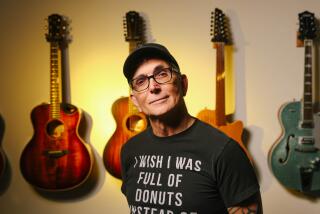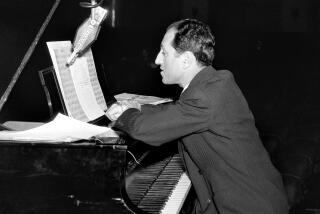PBS Shows to Salute the Prolific Brothers Gershwin
- Share via
NEW YORK — George and Ira Gershwin were so prolific, says conductor Michael Tilson Thomas, that a weekly series called “The Gershwin Show” could “go from now until who knows when.”
“One thing so astonishing about the Gershwins is the amount they wrote,” Thomas says.
Alas, there is no weekly series, but there is “Celebrating Gershwin” on public TV, two 90-minute specials airing tonight and Dec. 4. Thomas is host. The specials are part of the “Great Performances” series on the Public Broadcasting Service.
The tribute to the Gershwins is embodied in the range of performers--from Chita Rivera to Bob Dylan--who participated because of their admiration for the music.
Thomas says: “In the TV programs we wanted to do three things: We allow people to hear some music that they hadn’t heard in a long time; we brought in new things from recently discovered archives and other sources; we give a chance for a lot of different kinds of artists to perform. Diversity of artists was very important for the Gershwins.”
The two shows divide the Gershwin music basically into the 1920s and 1930s. Each contains portions of performances taped in Brooklyn and London.
Last March, a Gershwin Gala at the Brooklyn Academy of Music commemorated the 50th anniversary of George Gershwin’s death. The program concentrated on Gershwin’s music and the lyrics for Broadway of his brother, Ira. Thomas conducted. He also conducted a series of concerts of symphonic and operatic Gershwin music in June with the London Symphony, where he recently was appointed principal conductor.
“The London programs included Berg, Debussy, Ravel and Schoenberg,” Thomas says. “Gershwin was shown in the context of this. He was absorbing certain influences and putting his own stamp on music, which was influential. He was an original voice that the Europeans adored and still do to this day.”
The first show, “The Jazz Age,” begins with Gershwin’s first hit, “Swanee,” sung by Larry Kert in the style of Al Jolson. It ends with “King of Swing,” composed for the Radio City Music Hall Rockettes and the vaudeville dance team Buck and Bubbles. Young tap dancer Gregg Burge and the older dancers known as the Copasetics performed it in Brooklyn.
Thomas plays “Rhapsody in Blue” in the original orchestration for jazz band by Ferde Grofe.
“I think Gershwin was one of those rare people who discovered his true voice very early. I think he had it and knew it,” Thomas says.
“Then it was a question of how much he dared share it with the public. He always had a facile ability to write great hits. At the same time he had a great gift for writing profound and stirring music at a much deeper level.”
The second show, “‘S Wonderful,” concentrates on the music in the last years of Gershwin’s life. He died July 11, 1937, of a brain tumor. He was just 38. The show begins with Chita Rivera singing Gershwin’s favorite of his songs, “I Got Rhythm,” in the orchestration introduced by Ethel Merman. Liza Minnelli sings “Liza.” Ira Gershwin, who died in 1983, was her godfather, and she was named for that lyric.
Bob Dylan sings the 1930 song “Soon” in his own style. The program also features dancer Mikhail Baryshnikov and Hollywood orchestrator, pianist and bandleader Johnny Green, 79, who conducts Gershwin songs from movies.
“Johnny is spectacular in creating the style. Those are the exact arrangements used 50 years ago,” Thomas says.
“My family has association with the Gershwins going back generations. My grandfather (Boris Thomashefsky), George and Ira spent a good deal of time together while they were growing up. The Gershwins knew my dad (Ted Thomas) and were friendly with my uncles. I heard that music from the time I was conscious or even before that,” says Thomas, 42.
“A lot of my fundamental principles about how to play this music I’ve gotten from my father who got them from George Gershwin. I knew Ira.
“Although I had made some very well-selling Gershwin records over the years, I had never really performed all that much of it until about two years ago when I began to gear up for this big project.
“For me, George and Ira’s work has a particular haunted testimony that is essential to my life,” Thomas says. “It’s just as mysterious and profound as lots of what we might call the big classical masters of the 20th century.”
More to Read
The complete guide to home viewing
Get Screen Gab for everything about the TV shows and streaming movies everyone’s talking about.
You may occasionally receive promotional content from the Los Angeles Times.






